Priors Norton Manor (The Old Castle)
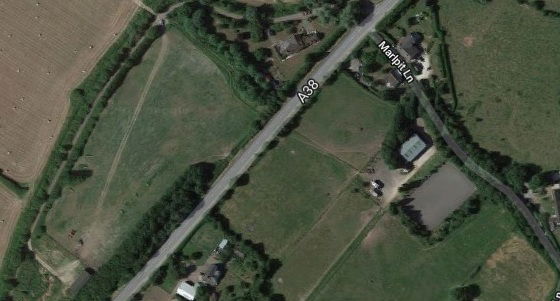
There is an area at Priors Norton that was once known as the Old Castle about which I have struggled to find much information.
The only mention that I have been able to find of The Old Castle amongst village records occurs in the 1910 Finance Act ‘Domesday Book’. At this time three owners of property were listed at The Old Castle; Leonard Roberts, E Gardner and Stock.
Jon Wrench of Dunsworth Villa grew up in this part of the village and has shared his memories and thoughts; “As regards to the Castle, unfortunately there is very little trace of anything left there now. There were only two parts to the feature, the section was called the Moat and it started near the layby on the A38 below the Church at Priors Norton. It followed the old road all the way to West House, unfortunately it has been filled in and the adjoining field was used as a landfill in the late 1970's. The corner of the Moat next to West House is still there but now it just looks like a pond. From West House it turned at right angles and was just a very wide ditch with steep sides and was lined by large elm trees. This part could never have been in water as the ground was rising. After about 300 yards it turned another right angle and headed towards the rear boundary of the adjoining house called The Orchards. Unfortunately, the new route of the A38 was cut through the middle of the site before the Second World War so anything in its path was destroyed”.
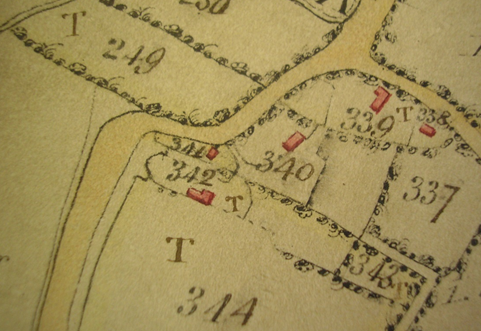
Plan extracted from the 1807 Inclosure Act for Norton
To aid orientation, Plot 340 on the map is now West House. There is a strip running alongside the old road adjacent to Plot 344 that ends as the road swings 90o that could perhaps have been the moat that Jon Wrench refers to and may even be the reason why the old lane makes such a dramatic turn here. There is no indication of any archaeological features in the area now.
Pat Ward, who had associations with West House and The Orchards going back to the 1950s, remembered an oblong shaped area of land, in what would have been Plot No 337 on the above map, that had uneven surface and was surrounded by trees still in the 1960s, about the same time as Jonathan’s memories. Pat tells us that Harry Cook, an old villager, used to say that was where the castle used to be. Pat also remembers the water feature to the rear of West House being known as the moat.
I now have a suggestion as to what this feature may have been, but no evidence to support it.
Starting this account from just after the Norman conquest, before 1147, the prebend which supported Nicholas, one of the secular canons of St. Oswald’s minster in Gloucester, included a mill and a hide and virgate of land in Norton. When in c1153 the minster was converted to a priory of regular canons, this and other prebends became its foundation endowment, and thereafter St. Oswald’s priory held an estate in Norton, which by 1289 was denoted Norton Superior, in distinction from Norton Inferior, the archbishop’s portion. The prior had a manor house on his Norton estate in 1309, and in 1327 the name Prior’s Norton (Norton Prioris) was in use.
The site of the manor house has never been identified but would likely have been a moated site at Priors Norton, perhaps the area known as the Old Castle ?
From the 1520s the manorial demesne and mill were let to tenants. The manor, including what we still know as the mill and Norton Court Farm, remained a possession of St. Oswald’s until the priory was dissolved in 1536, when Norton’s annual value was assessed at £10 14s. 8½d.
In 1544 the manor, with demesne house, mill and land, was sold by the crown to John Broxholme of London, who was licensed to alienate it in the same year to William Read. A small parcel of the manor was granted separately to Thomas Bell of Gloucester in 1544; “Priors Coppice in the manor of Norton, county Gloucester, late belonging to the Priory of St Oswalds, containing 2½ acres thin set with underwood of ten years growth, rated at 6s 8d an acre, and 2 acres set with oak and ash of 40 to 60 years growth, valued at 40s an acre”.
William Read was also owner of Boddington manor at this time and when he died in 1570, Norton passed to his brothers John, who also died in 1570, and Gabriel, of Bronsil, Eastnor, Hereford, who still owned it when he died c1593. Gabriel Read’s name appears amongst the manorial records for the Chamberlayne family of Maugersbury, in court rolls for Churchdown, Witcombe, Shurdington, Hucclecote and Bishop's Norton, from the 1590s. The references refer largely to Norton mill but they do also state that Gabriel was lord of the manor at Priors Norton at that time. The manor descended in the Read family, of Bronsil and Lugwardine, Hereford, until Richard Read sold it in 1702 to Thomas Savage of Elmley Castle, Worcs. Thomas Lane, who was related to Savage, occupied the house until his death in 1710.
In Sir Robert Atkyns’ work ‘The Ancient and Present State of Glostershire’, published in 1712, he recorded that a Lane “has a handsome house and good estate” at Apperley and they also had connections to The Leigh. The Lane family were also connected to Norton by marriage to the Brown(e) family who were at Bishops Norton Court at this time and for many years previous. The parish registers of Norton record the burial of ‘Old Mrs Lane of Nortons Court’ on 20 February 1693, and there are several other entries around this time that refer. Just inside the door to the tower at St Mary’s, Norton, is a memorial set in the floor that it is believed relates to this family.
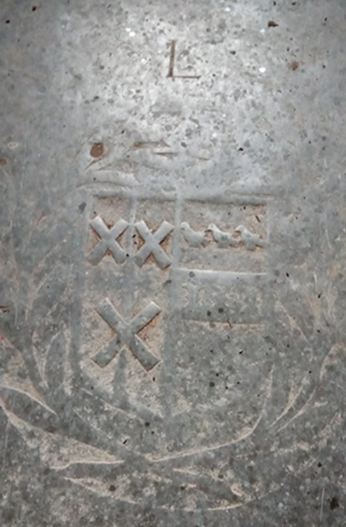
Whilst there are no names or dates on this memorial there are other clues that suggest it is most likely the memorial for William and Anne Lane. The letters W, L and A can still be seen around the edge of the stone and the left half of the coat of arms depicted shows the arms of the Lane family.
Following on from the Lane family, the manor of Priors Norton was acquired by Mary Prynce of Holme Lacy, Hereford. Sir Robert Atkyns’ publication of 1712 also stated that Mrs Prynce “had a good house and estate” at Priors Norton. In 1712, therefore, there was still an old manor house at Priors Norton that has since disappeared, apparently without trace.
Mary Prynce was connected to the Scudamore family who held large estates around Holme Lacy. When Mary died in 1719 she bequeathed her estates, including Prior’s Norton, in trust to Frances Scudamore who may possibly have been her great niece. Although Priors Norton is not actually named in her last will and testament, pictured below, the bequests included; “I, Mary Prynce of the City of Oxford, widow … all my freehold manors, messuages, lands, tenements, and hereditaments whatsoever I give to my said God daughter Frances Scudamore and her heirs for ever”.
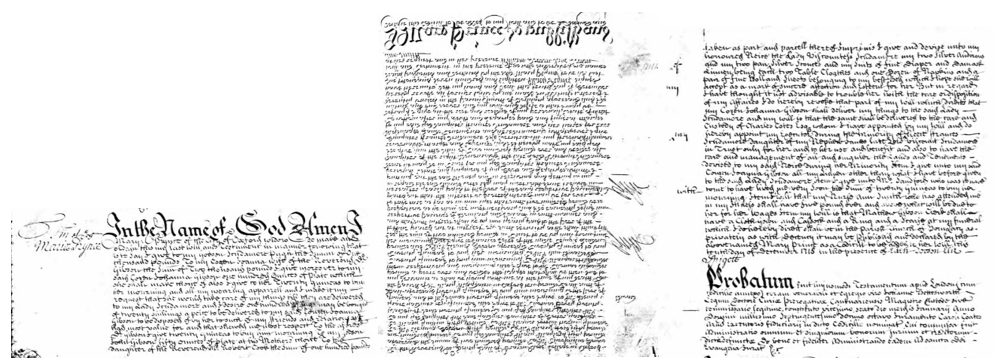
Will of Mary Prynce, dated 10 December 1718
Frances was born in 1711 and therefore a minor at the time of her inheritance. She married Henry Somerset, 3rd Duke of Beaufort, on 28 June 1729, but it wasn’t a happy marriage. Frances had an affair with William Talbot, 2nd Baron Talbot, which led her husband to file for divorce. Frances counter sued on the grounds that her husband was impotent but the divorce was finalised in March 1743. With the divorce Frances regained her property including that at Norton. Frances remarried Charles Fitzroy on 4 July 1748 who took on the surname Scudamore when his wife inherited the Holme Lacy estates. Frances died in childbirth on 27 February 1749.
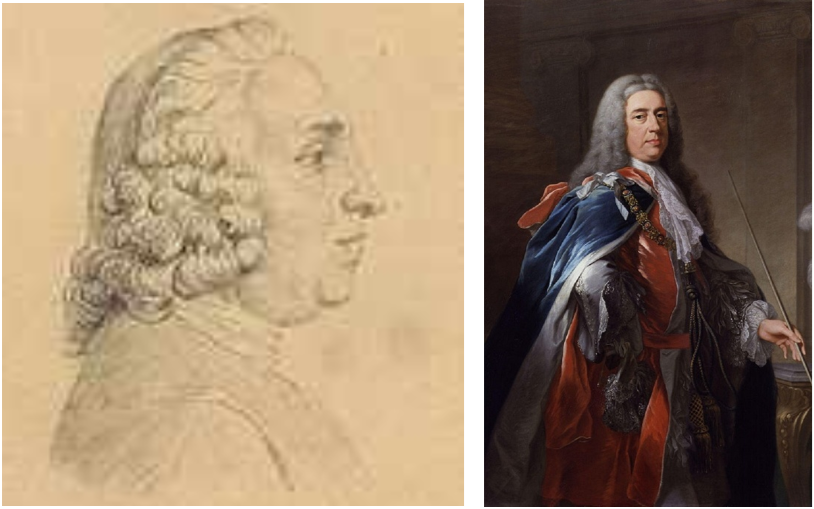
Henry Somerset and Charles Fitzroy
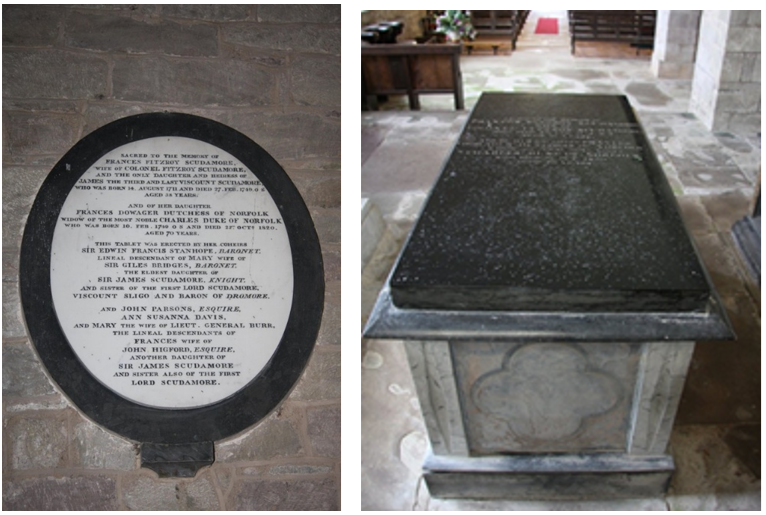
Final resting place of Frances and her daughter Frances at St Cuthbert's, Holme Lacy.
Frances’ memorial plaque reads; “Sacred to the memory of Frances Fitzroy Scudamore, wife of Colonel Fitzroy Scudamore, and the only daughter and heiress of James the third and last Viscount Scudamore, who was born 14 August 1711 and died 27 February 1949, aged 38 years. And of her daughter Frances Dowager Duchess of Norfolk, widow of the Most Noble Charles Duke of Norfolk, who was born 10 February 1749 and died 22nd Oct 1820, aged 70 years”.
Written by Dr Robert Eagles, the following account tells Frances Scudamore’s tale; “The Beauforts had married in 1729. It was an entirely predictable marriage for one of the most eligible bachelors in the country as his bride, Frances Scudamore, daughter of Viscount Scudamore, was a substantial heiress and seemed an appropriate choice. The summer after their marriage they appeared at the races at Monmouth, where Beaufort was a regular visitor, both because of his interest in horses but also because race gatherings were important opportunities for politicians to concert strategy in advance of elections and Beaufort was a prominent Tory leader in the west of England and Wales. For the next few years the marriage appeared to be secure enough, though there were no children, but by the late 1730s the duke and duchess appear to have been operating rather separate existences. In 1740 they had effectively separated and the duchess embarked on a highly charged relationship with Lord Talbot, who just happened to be one of the duke’s principal political rivals in Wales. In June a formal separation was agreed on between the duke and duchess, but Beaufort expected his wife to be discreet in the way she behaved. She was not. Over the next few months, the duchess and Talbot (who was also married) indulged in a risky liaison and were forced to buy the silence of some of their servants, who were more than aware of what was going on. Spied on in their chambers, they resorted to meeting out of doors. Bemused yokels observed them having sex in fields and woods, and watched them clamber in and out of each other’s carriages, parked for suspiciously long periods in country lanes. By 1742 Beaufort’s patience had run out and that year he sued for divorce in the Court of Arches. The duchess, unwilling to take the matter lying down, counter-sued and accused her husband of impotence. At this point one might have expected Beaufort to produce Margaret Burr as proof of his fecundity but, perhaps significantly, he did not. Instead, he opted to prove his wife’s accusations false by submitting to a humiliating demonstration of his manhood. Two options were open to him. One was to visit a brothel in the company of witnesses; the other was to invite trained medical men to observe him masturbating. He chose the latter. Beaufort retreated behind a screen until the most opportune moment, when his witnesses were summoned to certify that he was indeed capable of achieving an erection and ejaculating. The duchess’s case was thrown out, Beaufort’s honour was both restored and tarnished at one and the same moment, and his triumph left him free to sue Talbot for substantial damages. The case did not remain there, however. The Ecclesiastical Courts could grant a divorce, but to ensure the bastardization of any children born to the duchess – and thus protect Beaufort’s family name – and to allow Beaufort the chance to remarry an act of Parliament was required. And so the drama moved on to the House of Lords. In December 1743 Beaufort’s friend, Lord Gower, presented the bill to the Lords and in January 1744 the peers and bishops went into the case in detail. The previous hearings had, according to Horace Walpole, made for ‘delectable reading’ and it is clear that the case now before the Lords provided the upper chamber with some much needed light relief. It was noted in particular that there was a very good turnout on the bishops’ benches to hear the evidence presented against the duchess. It was also noteworthy that no counsel appeared for her at second reading. The bill went on to pass the Lords with just a half-hearted effort at amending the text brought on behalf of the Digby family, who considered themselves involved in the separation. From thence it was sent to the Commons, who spent all day sitting on the bill, no doubt also savouring every morsel, before passing it with a handful of minor amendments, which the Lords accepted without demur. The divorce became law early in March 1744. After all the hullabaloo, Beaufort did not have long to celebrate his success. Under a year after the bill was enacted he died at Bath in February 1745, thereby narrowly avoiding becoming embroiled in the Jacobite rebellion, in which some had expected him to play a key role. In time, the duchess was able to recover from her very public disgrace. By the time the case had come before the Lords Talbot had tired of her and they had split up. She eventually married again, this time to Charles Fitzroy, an illegitimate son of the duke of Grafton. Talbot separated from his wife and never remarried, though he was said to have fathered as many as 16 illegitimate children. He went on to be appointed Lord Steward and was promoted to an earldom, but suffered a miserable humiliation at George III’s coronation feast. Riding into the hall mounted on a charger, his horse, specially trained not to turn its rump to the king, opted to make its entrance backwards”.
The manor at Norton then descended to the infant daughter of Frances, also Frances, born in 1749, who became the second wife of Charles Howard, later 11th duke of Norfolk and Earl of Surrey, in 1771.

Frances and Charles Howard
Frances became insane soon after her marriage and was locked away at Holme Lacy for many years.
The Gamekeepers Deputations from the Gloucester Quarter Sessions (1711-1950) include an entry dated 28th August 1805, the only entry in these deputations in respect of the Manor of Priors Norton, when a Thomas Cooke was recorded as gamekeeper to the Lord of the Manor, Charles Howard, Duke of Norfolk. There are a number of records from the following 30 years that suggest that Thomas Cooke was actually in residence at Norton Court Farm.
At the time that the inclosures came to Norton in 1807 Norton Court Farm was Plot No 264 and was still owned by the Duke of Norfolk. The farmhouse was the only sizeable property in this area of the village so at some time in the eighteenth century the original manor house disappeared. The following plan shows Norton Court Farm at 1806.
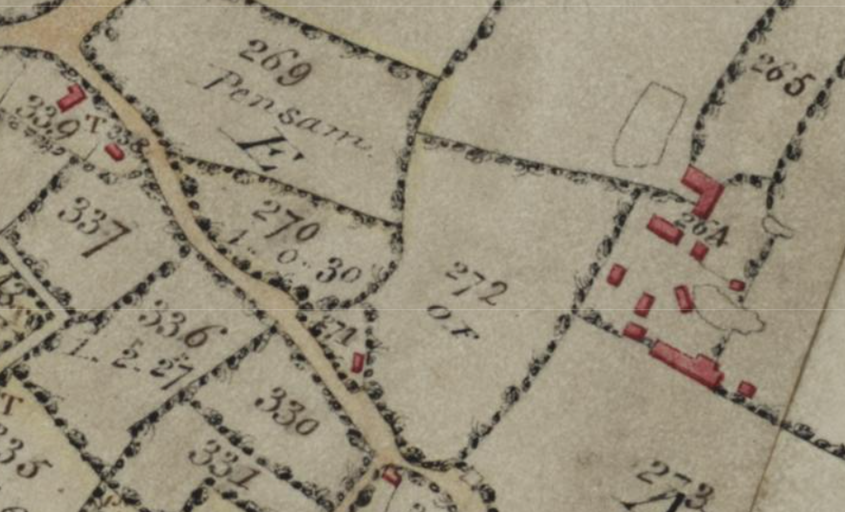
Charles Howard, 11th Duke of Norfolk, died in 1815 and his widow Frances in 1820. Bernard Howard, a cousin of Charles Howard, became the 12th Duke of Norfolk, and inherited the estate at Priors Norton.
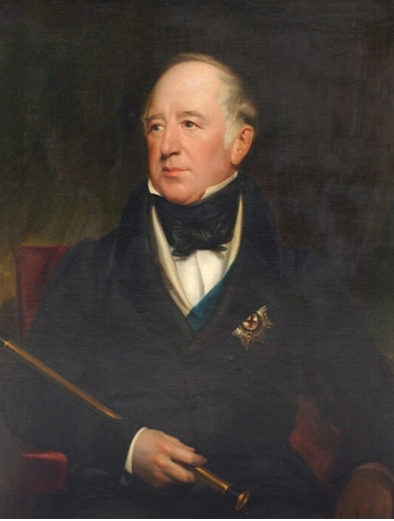
Bernard Howard
Into the 20th century the title ‘Lord of the Manor’ was still being used by the owners of Norton Court Farm, the Archers, and when they left the farm and moved to Norton Mill they took the title with them. 1939 is the last time I have seen the title used.
Whilst it is possible that the original manor house was located near the remains of the moat by West House there is certainly no hard evidence to support this. It is also possible that the manor house was located at what became Norton Court Farm and that the farmhouse now seen here is a later reincarnation of the original.
The histories of Norton Court Farm and Norton Mill are covered separately.
